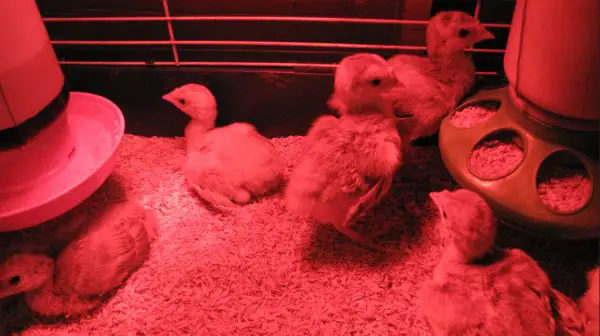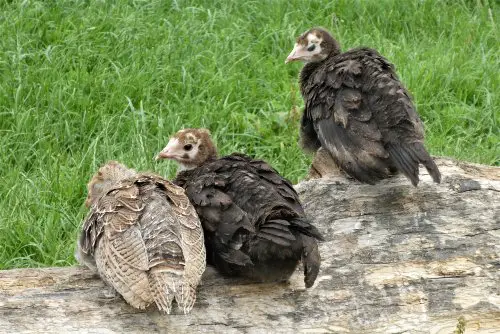We are going to assume that you already know the main difference when it comes to male vs female turkey i.e. that male turkeys cannot lay eggs. However, what about some of the other differences between the two sexes? How do you tell which is a male turkey and which one is a female turkey?
According to the National Turkey Federation, America has 2500 family run Turkey farms. It takes 75-80 pounds of feed to ready a 38-pound Tom turkey. Turkey eggs are tan with brown specks and are larger than chicken eggs. Incubation is 28 days for a turkey egg. When hatched, a baby turkey is called a poult and is tan and brown. Male turkeys are called toms and female turkeys are called hens.
Read on. We will give you absolutely every single piece of information that you need to know, when it comes to how to tell male from female turkey poults.
Can you sex turkey eggs before hatching?
No, it is challenging to sex turkey eggs before hatching through external methods. Unlike some other poultry species, such as chickens and ducks, where certain characteristics can sometimes be used to determine the sex of the embryos before hatching, turkey eggs do not have reliable external indicators for sex determination.
The only accurate way to determine the sex of a turkey chick is through internal methods, such as examining the reproductive organs after the chick has hatched. This is typically done by veterinarians or experienced poultry breeders.

Male Vs Female Turkey – How To Sex Turkeys
1. Feather Colorings
Generally speaking, male turkeys have brighter colored feathers than their female counterparts.
Of course, this is going to be very, very difficult to see if you do not have the two turkeys side by side.
However, if you have both a male and a female turkey of the same breed to hand, then it will be easy to tell which one is which.
2. Tail Fanning
Male turkeys need to catch the attention of females. This means that, on occasion, they will fan out their feathers.
This helps to show themselves off to female turkeys. You will never see a female turkey fanning her feathers.
That being said, males will not always fan their feathers. This means that you cannot 100% rely on this to determine whether a turkey is a male or female.
It is just a good indicator if you catch it happening. It tends to happen the most during the breeding season.
3. Feathers on Their Head
Next up when comparing male vs female turkey will be feathers on their heads.
Not a single breed of turkey will have males that have feathers on the top of their head. They will always be completely bald.
Females will not have easy-to-spot feathers on their heads. However, if you get in close to them, you should see smaller feathers.
If there are any feathers on the head, then it is 100% a female turkey.
You can do these when the turkey poults are 8 weeks old, if the chick have got a line of hair (feathers) a long the neck it is a female.
4. Leg Spurs
If you look on the legs of a male turkey, then they will have spurs. These spurs get bigger as the turkey grows older.
Females do not have these spurs. There is no need for them.
The whole reason that males have spurs is so that they can fight other turkeys for the attention of the females.
Female turkeys do not have to worry about this at all, because they will never have to fight other females for attention. This is because turkeys are not monogamous.
It is difficult to see the leg spurs in younger turkeys. This is because they do not start to develop properly until the turkey is a few months old and, even then, they are still going to be fairly slow-growing.
You should only be using the leg spurs as a way to determine whether a turkey is a female or male once they are in adulthood.
5. Male Vs Female Turkey Size
Male turkeys are always going to be larger than the females.
If you look at the two side by side, then it is going to be easy to tell the difference between a male and a female turkey.
Of course, this is something that you can only do when the turkeys are roughly the same age. You can’t exactly compare a chick against an older turkey, right?
It is also worth noting that chicks are always going to be exactly the same size when they have just hatched.
This means that you will need to use other methods to determine which turkey is male and which is female.
We will discuss that part in a couple of sections.
6. Breast Beards
Male turkeys will always have breast beards. Only a few females will have them.
Obviously, this is not going to be a guaranteed way to tell the two apart.
However, it is another little indicator that you can use if you are at a complete loss as to what sex a particular turkey is.
7. How to Tell Male From Female Turkey Poults
The rule of thumb when it comes to how to tell male from female turkey poult is this:
Look between the legs of a turkey chick and you will see a vent.
This vent is the main sex characteristic of a turkey. If you have a male turkey then you will notice that the vent is a bump. If you have a female turkey, then the vent will be flattened.
In general this is how tell male from female turkey poults.
To be honest, if you do not have experience sexing chicks, then we wouldn’t recommend that you do it yourself.
It can cause a small amount of pain to the turkey and, even then, it is going to be tough to know what you are looking for.
There is a reason why professional chicken sexers are so in demand and have to go through a ton of training before they are let close to any sort of commercial bird.
Now, as we said, unless you are experienced it is tough to know exactly what you are looking at. Some females can look like males to the untrained eye.
Therefore, if you have never sexed turkeys successfully before, do not rely on your knowledge alone here. Call in an expert if you really do have a lot of turkeys that you need to sex.
8. Male Vs Female Turkey Poults
Another very interesting method on how to sex turkey poults is by gently grabbing the baby turkey from above, and see if the legs are hanging down. If the legs are hanging down it should be a female turkey chick, otherwise it should be a male.
Check the video bellow in order to see this method of how to tell if a baby turkey is male or female.
9. Male Vs Female Turkey Behavior
Most breeds of turkey are incredibly territorial.
However, it will never be the female that is territorial.
Instead, it will be the male. If you notice that one of your birds is aggressive, particularly from a younger age when they are harder to sex, then it is a good chance that you are dealing with a male.
The aggression will likely become a lot worse once the turkey reaches sexual maturity and you have other male turkeys in the flock.

At what age can I reliably sex turkeys based on their physical characteristics?
Determining the sex of turkeys based on physical characteristics becomes more apparent at 8 to 12 weeks of age. Some sexual dimorphism starts to appear, making it easier to distinguish between male vs female turkey.
Raising Male Vs Female Turkey Commercially
Outside of mating with female turkeys, the males really have no purpose in the commercial turkey world.
They can’t lay eggs, after all. Therefore, a few of the ‘better’ males may be kept to allow breeding.
The rest of the males will likely be used for meat. In some turkey farms, the males will be killed as soon as they are chicks.
This is because it is more profitable to raise female turkeys for eggs and meat than it is to feed male turkeys for a year or so without seeing a return.
If you homestead, then you should be fine raising male turkeys, just bear in mind that there are not really any fast-growing heritage turkey breeds.
This means that you will have to have this turkey for over a year before you can use it for meat.
Final Thoughts
When it comes to discerning the gender of turkey poults, understanding the distinctions between males and females requires a straightforward guideline:
Simply take a glance between the legs of a young turkey chick, and you’ll notice a small opening known as the vent.
This vent serves as a significant sexual characteristic in turkeys. For male turkey poults, the vent is visibly elevated, resembling a slight bump. On the other hand, female turkey poults exhibit a more flattened and less prominent vent.
This basic method provides a foundational understanding of how to distinguish between male and female turkey poults.
However, if you’re not experienced in the art of sexing chicks, it’s prudent to exercise caution. Attempting to sex poults without proper knowledge can lead to discomfort for the birds, and even then, the subtleties involved can be challenging to interpret accurately. Professional chicken sexers undergo rigorous training for a reason—they’re equipped to handle the task of distinguishing between sexes in commercial bird populations.
It’s worth noting that even for those who lack experience, spotting the differences accurately can be perplexing. Some female turkey poults might exhibit features that bear a resemblance to males, leading to potential confusion.
Therefore, if you’re unfamiliar with the process of sexing turkeys and have never successfully accomplished it before, it’s advisable not to solely rely on your own judgment. Especially if you’re dealing with a considerable number of turkeys in need of sexing, enlisting the help of an experienced expert can alleviate any uncertainty. Seasoned professionals possess the know-how and finesse to accurately determine gender without causing undue stress to the birds. Their expertise ensures the process is carried out seamlessly, benefitting both the turkeys and the caretaker.
